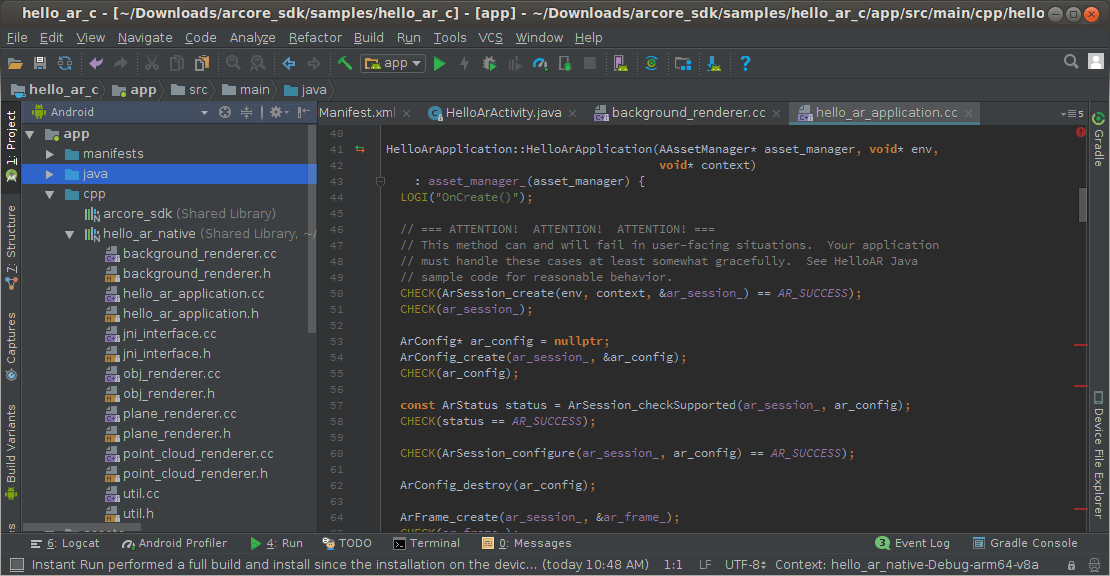

- #Install android ndk apk
- #Install android ndk update
- #Install android ndk for android
- #Install android ndk software

#Install android ndk apk
Most Android implementations allow users to manually install APK files only after they turn on an "Unknown Sources" setting that allows installation from sources other than trusted ones like Google Play. As is the case with many file formats, APK files can have any name needed, but it may be required that the file name ends in the file extension for being recognized as such. dex files), resources, assets, certificates, and manifest file. An APK file contains all of a program's code (such as.
#Install android ndk for android
To make an APK file, a program for Android is first compiled using a tool such as Android Studio or Visual Studio and then all of its parts are packaged into one container file. app on HAP for HarmonyOS or a Debian package in Debian-based operating systems.
#Install android ndk software
Overview ĪPK is analogous to other software packages such as APPX in Microsoft Windows. A file using this format can be built from source code written in either Java or Kotlin.ĪPK files can be generated and signed from Android App Bundles. The Android Package with the file extension apk is the file format used by the Android operating system, and a number of other Android-based operating systems for distribution and installation of mobile apps, mobile games and middleware. Ubuntu Touch via Linux Terminal with WayDroid container and HarmonyOS under Ark Compiler: Mobile apps.

I get error emulator: qemu backend: argv = "./emulator/qemu/darwin-x86_64/qemu-system-armel"Įmulator: qemu backend: argv = qemu backend: argv = "-no-audio"Įmulator: qemu backend: argv = "-no-window"Įmulator: qemu backend: argv = "-verbose"Įmulator: Concatenated backend parameters: #avdmanager create avd -n Nexus6P -k "system-images android-23 google_apis x86_64" -b google_apis/x86_64 -c 100M -d 7 -fĪvdmanager create avd -n test -k "system-images android-25 google_apis armeabi-v7a" -b armeabi-v7a -c 100M -d 7 -fĬd $(dirname $(which emulator)) &. Sdkmanager "system-images android-25 google_apis armeabi-v7a" I'm using brew cask install android-sdk and my configuration is this export ANDROID_SDK_ROOT=/usr/local/share/android-sdkĮxport ANDROID_HOME=/usr/local/share/android-sdkĮxport PATH="$ANDROID_SDK_ROOT/platform-tools:$ANDROID_SDK_ROOT/tools:$PATH" If everything goes smoothly on a moderate network connection you can expect this process to take 2-4 I'm trying to run the emulator but I get android sdk not found, has anyone see same problem. Install Eclipse, IntelliJ, Android Studio, or your other favorite IDE.
#Install android ndk update
Note: It looks like there might be an issue with brew update and the android-sdk formula.Periodically run these commands again to ensure you're staying up to date: brew update Update your paths (bonus points to a better solution to the hardcoded build tools version): export PATH=$ANT_HOME/bin:$PATHĮxport PATH=$ANDROID_HOME/platform-tools:$PATHĮxport PATH=$ANDROID_HOME/build-tools/19.1.0:$PATH Update your environment variables: export ANT_HOME=/usr/local/opt/antĮxport ANDROID_HOME=/usr/local/opt/android-sdkĮxport ANDROID_NDK_HOME=/usr/local/opt/android-ndk Check out the "Configuring VM Acceleration on Mac" section here: Install all of the Android SDK components (you will be prompted to agree to license info and then this will take a while to run): android update sdk -no-ui Use Homebrew to install Android dev tools: brew install ant Make sure the doctor is happy (do what it tells you): brew doctor Install Homebrew: ruby -e "$(curl -fsSL )" XCode command line tools are installed ( xcode-select -install will prompt up a dialog).Prerequisites (for Homebrew at a minimum, lots of other tools need these too): Here is a high level overview for what you need to do to get most of an Android environment setup and maintained.


 0 kommentar(er)
0 kommentar(er)
